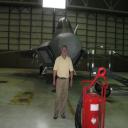Yahoo Answers is shutting down on May 4th, 2021 (Eastern Time) and beginning April 20th, 2021 (Eastern Time) the Yahoo Answers website will be in read-only mode. There will be no changes to other Yahoo properties or services, or your Yahoo account. You can find more information about the Yahoo Answers shutdown and how to download your data on this help page.
Trending News
Why do jets sometimes leave a trail but not always?
Why do jets only leave a trail sometimes? Is it something they turn on and off? If so, why do they need to turn it on, what does it do for them?
10 Answers
- David SLv 61 decade agoFavorite Answer
condensation trails, or contrails are ice crystal that form from the hot exhaust gases of aircraft engines. They are classified as a type of cirrus cloud, as they have the same composition. The exhaust invariably contains water vapor and coming in contact with the cold air at high altitudes turn instantly into tiny ice crystals. Depending on altitude, air temperature and air humidity, contrails may form at lower altitudes, or be more visible, or linger longer than usual. Typically, contrails form at FL280 (28,000feet) or so and up. There is an upper limit to visible contrail formation but common airplanes cannot fly that high. On commercial aircraft, contrails are not something that is controlled in anyway by the pilots. The only way they could influence this is by flying at a lower altitude, which would be detrimental to fuel consumption and passenger comfort. (air is more dense at lower altitudes, so more drag, and more fuel to create the right fuel-air mix for combustion, and air is generally rougher at lower altitudes)
high performance aircraft sometimes have short-lived, skinny vapor trails forming from the wing tips during high g maneuvers because of the friction caused by the wings slicing through the air causes some vapor to form. Again this is dependent on atmospheric conditions. (temperature, humidity, etc)
HOWEVER, these is a distinction as show aircraft sometimes do have a smoke generator in engine exhaust or on the wingtips which can be turned on or off by the pilot The smoke from these devices is thicker, lingers longer and is sometimes colored. It is easy to distinguish from the aforementioned vapor trails.
- masvx800Lv 51 decade ago
The trails are called contrails. They're caused by the humidity in the air condensing and leaving a long, thin little cloud behind the plane. All planes can cause them, not just jets, just check out footage of B-17s over Europe in WW2. Contrails can also be caused by any forced change in the air's density, like when a fighter jet pulls a high g turn, contrails are often seen at the wing tips. There are also some really cool pictures of jets breaking the sound barrier and causing unusual contrail patterns along the shock wave.
Source(s): Weather channel, aeronautical knowledge. - Anonymous1 decade ago
Whether or not a trail is produced is essentially a function of temperature. The pilot does not get a choice in this
All engines burning carbon fuels produce a hot exhaust that includes water in the form of steam. In the very cold air (typically -70C) the steam freezes almost instantly to produce a trail of ice crystals which is what you see. Usually occurs at heights above about 30,000 feet.
Ian M
- Vincent GLv 71 decade ago
Why do you see your breath sometimes and not other?
You see it because it is cold, and not when the air is warm, right?
Same thing with aircraft. If the plane flies at an altitude which is not cold enough, or where humidity is too low, then the contrail will evaporate right away.
Source(s): Aerospace engineer - How do you think about the answers? You can sign in to vote the answer.
- Pilsner ManLv 71 decade ago
What most of the people above said. I'm not going to repeat it, I just wanted to let "Best Pilot on Y!A" know that there are many, many, many more skin cells on the human body than the times this has been asked. Of course, he is an aviation "expert", not a biology major.
- Anonymous1 decade ago
they always leave a trail from the engines, its to do with air density whether it shows or not, something like that. its how sometimes you can see fumes from car exhausts when its cold.
they sometimes dump fuel from the wing tips which also leaves a trail.
- Anonymous1 decade ago
The heated air their engines blow off can create water vapor if there is enough water in the surrounding air at the time. When the vapor cools it leaves a "cloud".
- 1 decade ago
If they're high enough up, you get them. If not, you don't. It's pretty much just condensing water vapour. Usually about 30,000 feet is high enough
- Anonymous1 decade ago
It depends on how high they are. It's exhaust that freezes in the lower atmosphere





